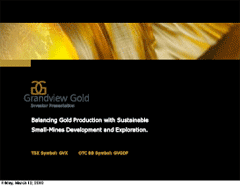» Peru
» Red Lake Gold District
¦ Regional Activity
¦ Regional Geology
¦ Past Exploration
¦ Deposit Types
¦ Mineralization
¦ Geology
¦ Past Exploration
¦ Deposit Types
¦ Mineralization
¦ Drilling Results
¦ Resource Estimates
¦ Geology
¦ Past Exploration
¦ Deposit Types
¦ Mineralization
¦ Drilling Results
¦ Resource Estimates
¦ Geology
¦ Past Exploration
¦ Deposit Types
¦ Mineralization
¦ Drilling Results
¦ Resource Estimates


Dixie Lake
Geology
The aeromagnetic profile in the vicinity of the Dixie Lake property is characterized by major truncations and offsets that occur on an east-west belt wide scale. This pattern is observed to extend from the Birch-Uchi belt in the east, through the Dixie Lake property, and up towards the northwest where it is truncated by a younger east trending structure south of the Madsen mine. Several north trending brittle faults are observed to offset this structure east of the Dixie Lake property. This structure is believed to be associated with a high strain zone that hosts the 88-04 zone.
The rocks of the Dixie Lake property are associated with a broad east-west trending belt of mafic to felsic meta-volcanics, metasediments, that are intruded and folded by a suite of granitic batholiths. The main rocks type at Dixie Lake that belong to the Conferderation Assemblage include: calc-alkaline mafic to intermediate volcanic rocks, pillowed lavas, and intermediate to felsic pyroclastics. These have been subjected to amphibolite grade facies metamorphism. Metasedimentary rocks comprise wacke, siltstone, conglomerate, and magnetite iron formation. Crystalline rocks north of the Dixie Lake property include various types of granite, quartz-monzonite, and granodiorite. Those towards the south of the property consist of tonalite and quartz-diorite.
The volcanic rocks that belong to the Confederation Assemblage are describe comprising gabbro, mafic flows, pillows, volcaniclastic rocks intercalated by felsic volcanic flows and pyroclastics. High level intrusive rocks have been identified as gabbros with relict pyroxenite and amphibolite units. Poorly documented felsic intrusive rocks are believed to be common, i.e., one small plug is known east of the known gold mineralization. Other intrusives include mafic dikes, which range from lamprophyres to gabbro/diorite. Sedimentary rocks include iron formation, wacke, siltstone, and argillite.
Structural features observed at the Dixie Lake property are believed to be the product of two major deformation events (Lee 2004). An early north-east trending S1 is overprinted by a north-west S2. These coincide to D1 and D2 deformation events, respectively. S1 is observed as meter-scale isoclinal folds associated with low strain zones. A stretching lineation, quartz fibres, and fold hinges are all parallel and all follow the same plunge. The deformation event S2 is believed to be responsible for regional scale west north-west trending high strain zones that have a significant shear component.
This zone is believed to host the 88-04 zone, which is influenced by D2, as well as the Main, North, and C-zones. Oriented drill core measurements enabled the Alberta Star and Fronteer Joint Venture to determined that the Au-rich shoot at 88-04 follows the stretching lineation found in the plane of S2. The highest strain is recorded in the hangingwall of the 88-04 zone. Ore bearing rocks "plunge steeply to the northwest, parallel to the projection of the L2 stretching lineation".











